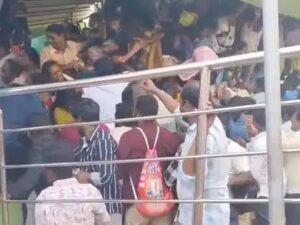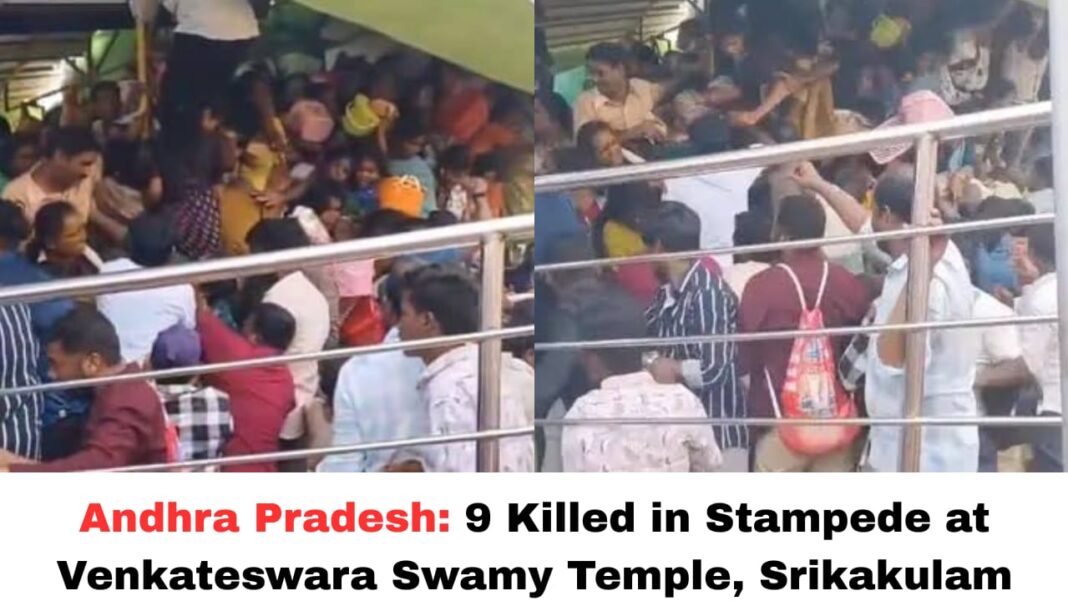Digital News Guru Andhra Pradesh Desk:
Venkateswara Swamy Temple, Kasibugga – Tragedy in the Hills of Srikakulam
On the morning of 1 November 2025, a devastating crowd surge at the Venkateswara Swamy Temple in Kasibugga (Palasa mandal, Srikakulam district, Andhra Pradesh) claimed the lives of at least nine devotees and injured many others—turning what should have been a holy observance into a scene of horror and chaos.
The Moment of Disaster
The stampede unfolded during the observance of Karthika Ekadashi, a significant day in the Hindu calendar when thousands gather for worship and darshan. The temple, described by officials as having a capacity of around 2,000–3,000 people, was inundated by a vastly higher number—reports estimate up to ~25,000 devotees that morning.

As devotees queued for darshan, multiple failures in infrastructure and crowd-management triggered the disaster. A railing at the entry stairwell reportedly collapsed under crowd pressure, sending many falling from a height, while the entry and exit routes were identical, creating dangerous bottlenecks. One eyewitness described a sea of bodies, with many women carrying puja baskets in hand, suddenly trapped with little space to move as the crush intensified.
The Human Toll
While early reports varied slightly, authorities confirmed nine dead, including eight women and a 13-year-old boy (Lotla Nikhil) among the deceased. Several others—estimated at around 15–25—were injured and rushed to hospital, with multiple cases serious enough to be transferred to larger facilities.
Management & Oversight Failures
Investigations quickly pointed to critical lapses:
- The temple is privately managed, built on 12 acres by an individual (Harimukund Panda) and not under the direct oversight of the state’s Endowments Department.
- Organisers did not notify local authorities about the large gathering, nor did they seek approval or deploy formal crowd-control arrangements.
- Construction was reportedly ongoing in the area where devotees gathered, and safety norms (such as separate entry/exit points) were not adhered to.
These points raise stark questions about regulatory gaps, especially when religious gatherings draw unexpectedly large numbers.

Authorities’ Response & Relief Measures
The state government, led by Chief Minister N. Chandrababu Naidu, expressed deep regret, calling the incident “extremely heartbreaking” and ordering a thorough inquiry into the cause and accountability of the incident.
On the national level, Narendra Modi announced ex-gratia payments: 2 lakh each for the next of kin of the deceased, and 50,000 for the injured, to be disbursed from the Prime Minister’s National Relief Fund (PMNRF).
Wider Implications
This tragedy again highlights the growing risks associated with large-scale religious gatherings in India. Despite several prior landmark crowd disasters (for example, at pilgrim sites), the core issues often remain: inadequate planning, flawed infrastructure, and weak enforcement of safety norms.
Specifically:
- Capacity vs actual attendance: The gap between official capacity and actual numbers indicates a failure in monitoring and controlling crowd volumes.
- Infrastructure fragility: A collapsed railing indicates basic structural weakness at a site expected to handle large crowds.
- Private vs public oversight: Private temples often fall outside strict state oversight frameworks, increasing risk when they host huge gatherings.
- Regulatory awareness: Without prior notification to authorities, relief and crowd control become reactive rather than preventive.

What Needs to Be Done
Moving forward, certain measures are essential:
- Mandatory advance crowd estimation: Before major festivals/events, organizers should submit expected attendance figures to authorities.
- Separate entry and exit routes: Minimizing crossover points reduces bottlenecks and panic triggers.
- Structural audits: Periodic checks on railings, staircases, and other load-bearing elements should be enforced—especially in high-footfall zones.
- Clear regulatory jurisdiction: Even privately-managed religious sites must comply with state safety norms when hosting large gatherings.
- Rapid response mechanisms: Local hospitals, ambulances and first-aid stations should be pre-positioned when large gatherings are planned.
- Public awareness: Devotees should be informed of peak hours, crowd densities, and advised to avoid high-risk slots.
Conclusion
The Kasibugga incident is a sobering reminder that faith, however sincere, must be matched with rigorous preparation and safety planning when thousands gather in devotion. Nine lives were lost on a day meant for spiritual renewal—and hundreds more left injured or shaken. As the inquiry unfolds, it is imperative that lessons are institutionalised so that such tragedies are prevented in future.
You May Also Read: India’s Economy Seen Close to 7% Growth in FY26, Says CEA V. Anantha Nageswaran








